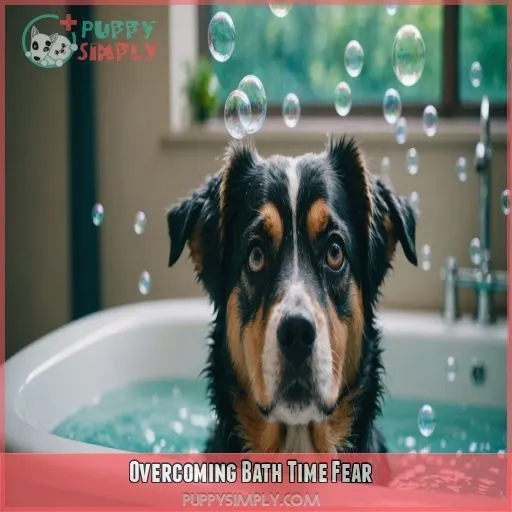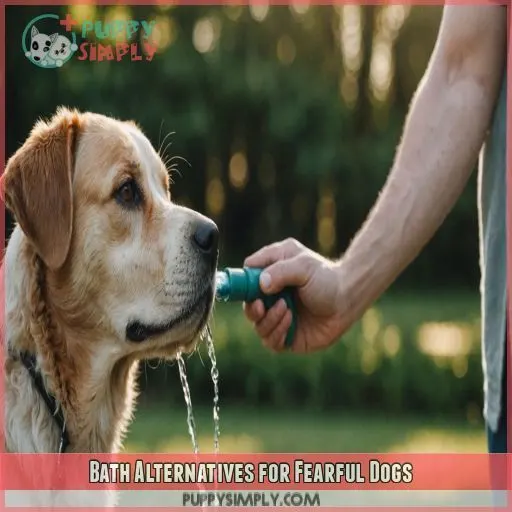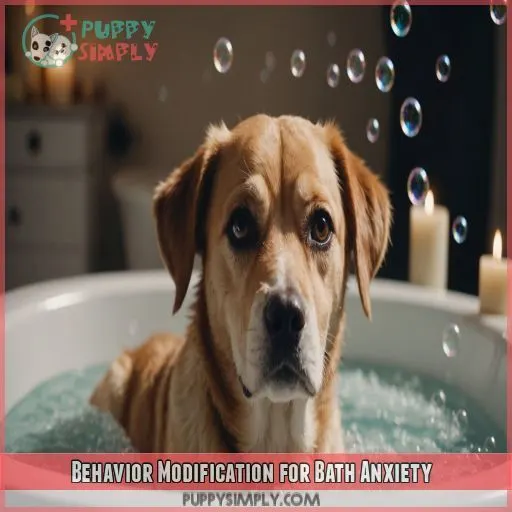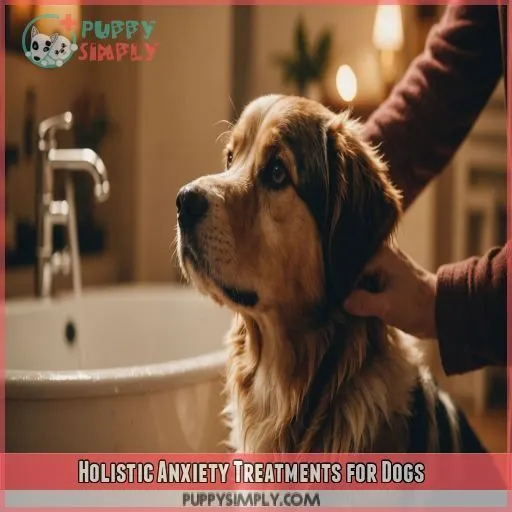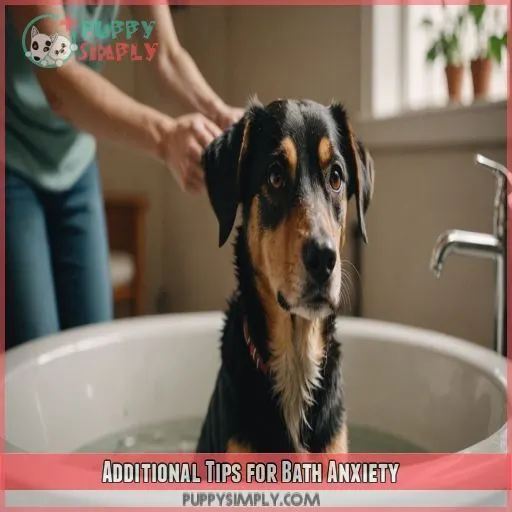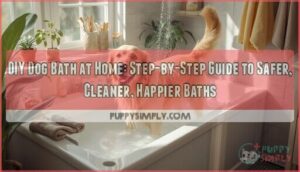This site is supported by our readers. We may earn a commission, at no cost to you, if you purchase through links.
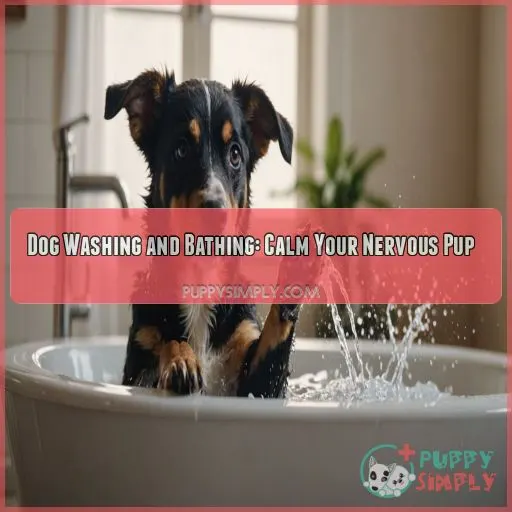
It’s important to understand why your dog might be anxious.
This could be due to unfamiliar experiences, discomfort, or even negative memories.
To help your dog relax, create a calm and rewarding environment.
Use gentle water flow and make sure the water is lukewarm.
Offer treats and praise to build positive associations with bath time.
Remember to be patient and consistent.
Take a gradual approach to help your dog overcome their fears.
If needed, consult a professional for guidance.
Table Of Contents
- Key Takeaways
- Understanding Dog Bath Anxiety
- Making Baths Less Scary
- Overcoming Bath Time Fear
- Bath Alternatives for Fearful Dogs
- Behavior Modification for Bath Anxiety
- Holistic Anxiety Treatments for Dogs
- Additional Tips for Bath Anxiety
- Frequently Asked Questions (FAQs)
- How to calm a nervous dog for grooming?
- How do you give your dog a bath without them freaking out?
- How do you give a crazy dog a bath?
- How do you wash an uncooperative dog?
- How do I know if my dog is nervous?
- How often should I bathe my dog?
- Are there natural ways to calm my dog?
- What treats will distract my dog?
- Do dogs hate running water?
- Conclusion
Key Takeaways
- Dogs may find baths stressful due to unfamiliar experiences, loss of control, discomfort, or negative memories.
- Creating a calm environment with gentle water flow, lukewarm water, treats, and praise can help your dog associate bath time with positive experiences.
- Gradual exposure, positive reinforcement, and family participation are key to building trust and making bath time enjoyable for nervous dogs.
- Alternative cleaning methods, such as dry shampoo, bath mitts, and damp cloth cleaning, can be used for dogs who are scared of traditional baths.
Understanding Dog Bath Anxiety
Is your furry friend freaked out by bath time? You’re not alone. Many dogs find the whole bathing shebang stressful, but there are ways to help them chill out.
Let’s take a closer look at why your pup might be nervous about baths and explore practical tips to make this necessary chore less of a nightmare for both of you.
Unfamiliar Experience and Loss of Control
Dogs often view baths as an unfamiliar, overwhelming experience. The sensory overload of new sounds, smells, and sensations can trigger anxiety. Couple that with the loss of control from being forced into a bath, and it’s no wonder your pup may feel nervous. Here are some tips to help calm your dog’s bath anxiety:
- Sensory Overload: The sound of running water, the feel of wet fur, and the smell of shampoo can be a lot for a dog to process.
- Forced Experience: Dogs don’t typically choose to bathe, so it can feel like a forced and uncomfortable situation.
- Trust Building: Focus on building trust and showing your dog that bath time is nothing to be scared of.
Discomfort and Negative Memories
Dogs can find the physical sensation of being bathed uncomfortable. They may also have negative memories associated with baths, such as past trauma from scalding water, soap in their eyes, or harsh chemicals causing eye irritation. These experiences can create a fear of baths and water in general.
Puppy Fear Period and Outdoor Vs. Indoor Baths
The puppy fear period, which typically occurs between 8-10 weeks, can also contribute to your pup’s bathtime jitters. During this sensitive stage, any negative experiences can leave a lasting impression, so it’s important to be mindful of their comfort and safety.
- Outdoor Baths:
- Cold hose water can be a shock to your pup’s system, and the restraint of a leash only adds to the stress.
- Indoor Baths:
- Offer the comfort of adjustable water temperature and the security of natural contours in bathtubs, showers, or sinks.
- A controlled environment means less anxiety for your furry friend.
Making Baths Less Scary
If your pup’s bath time blues have you stumped, it’s time to roll up your sleeves and make some changes. We’ll show you how to transform this tough task into a calm and rewarding experience for both you and your furry friend.
Non-Slip Surface and Distractions
Now, let’s tackle the actual bath. First things first: safety. Prevent slipping by placing a bath mat or towel in the tub. You can also use peanut butter or baby food as a tasty distraction on the tub walls or shower door. Check out the table below for some quick bath mat options:
| Bath Mat Type | Description |
|---|---|
| Row 1 | Description 1 |
| Row 2 | Description 2 |
| Row 3 | Description 3 |
| Row 4 | Description 4 |
Gentle Water and Rewards
Calming your nervous pup during bath time can be tricky, but gentle water and rewards can really help make it less scary. Here are some tips to help you out:
- Use a gentle water flow: Instead of using a showerhead, which can be intimidating with its strong, direct spray, fill a bucket with warm water and gently pour it over your dog’s body.
- Offer high-value treats: Distract your dog with their favourite treats during the bath. This can help create positive associations with bath time.
- Timing is key: Give treats at the right moments to reinforce calm behaviour. For example, offer a treat when your dog enters the tub willingly or stays still during rinsing.
- Create a positive routine: Incorporate treats and praise throughout the bath routine to make it a more enjoyable experience for your pup.
- Build a positive association: Focus on creating a relaxing and rewarding environment to help your dog associate bath time with happiness and treats.
Ideal Water Temperature and Shampoo Choices
You don’t want to scald your pup, so test the water first. Lukewarm water is best, between 90 and 98 degrees Fahrenheit. Use your elbow or hand to check, and adjust as needed. You can even use a thermometer for precision.
Go for a dog-specific, unscented or lightly scented shampoo. Natural, mild shampoos can prevent irritation and make bath time more pleasant for your nervous pup.
Overcoming Bath Time Fear
Is your dog terrified of bathtime? There’s hope yet! You can help your pup overcome their bath time fears and even learn to enjoy it with the right approach and some patience.
Desensitization and Counterconditioning
Desensitization and counterconditioning are techniques used to change a dog’s emotional response to bath time. It’s like helping them rewrite their feelings about the whole experience.
Gradual Approach and Professional Help
If your pup is nervous about bath time, a gradual approach is key. You can do this by breaking down the bath time process into small steps and rewarding your dog for each step they master. Here’s how:
- Reward your dog for approaching the bathtub.
- Then, reward them for entering the tub.
- Next, reward them for water being turned on and off.
- Finally, reward them for water being poured on their body.
If you’re unsure, consult a professional. A certified positive reinforcement trainer or veterinary behaviorist can provide expert guidance.
Building Trust and Positive Associations
The key to helping your dog overcome their fear of bath time is to build trust and create positive associations. It’s all about changing their emotional response and making bath time feel like a fun, rewarding experience. Here are some tips to achieve this:
- Gradual Exposure: Take it slow and introduce your dog to the bathtub, shower, or sink at their own pace. Reward them for approaching, entering, and eventually, for staying calm when the water is turned on.
- Positive Reinforcement: Offer treats and praise generously throughout the process. This helps your dog associate bath time with tasty snacks and loving words.
- Family Participation: Get everyone involved! Bath time can be a fun family activity where everyone takes turns pouring water, scrubbing gently, and offering treats.
Bath Alternatives for Fearful Dogs
If your dog has a deep-seated fear of baths, you might be wondering if there are any alternatives. Good news: there are several options to explore, from dry shampoo to damp cloth cleaning. Let’s take a look at these creative solutions to keep your pup clean and calm.
Do You Really Need to Bathe Your Dog?
Unless your dog needs medicated baths, there may be no health benefit to giving them a full bath. Instead, consider training your dog to be comfortable with water and being scrubbed. Forcing your dog into a bath may lead to years of unpleasantness surrounding bathtime. Take your time with the training process and avoid rushing it. It’s possible to train your dog to enjoy bathtime.
Key Considerations:
- Breed Specifics: Some breeds may require less frequent bathing due to their coat type and natural oils.
- Skin Health: Consult a veterinarian if your dog has skin issues to determine if bathing is necessary.
- Frequency Needed: Assess your dog’s lifestyle and coat type to determine an appropriate bathing schedule.
Dry Shampoo, Bath Mitts, and Damp Cloth Cleaning
If your pup is scared of water, there are alternatives to traditional baths.
You can try dry shampoo, a foam rubbed into their fur without water.
While it might not deep clean, it can freshen them up.
Or, use bath mitts, disposable fabric pockets with no-rinse shampoo.
These are great for a quick clean.
You can also spot-clean with damp cloths or towels, adding soap if needed.
These methods can help your nervous pup stay fresh between baths or groomer visits.
Self-Rinse Method and Training for Water Comfort
If your dog is fearful of baths, there are alternatives to help them get clean while avoiding the tub. One method is the self-rinse approach, which involves:
- Training your dog to enter a tub or pool of water on their own
- Encouraging them to move around and play in the water, allowing their natural movements to clean their coat
- Interacting with water in a fun, low-pressure way
This method may require more effort in training, but it can turn bath time into pool training, helping your dog:
- Overcome their fear of water
- Associate water with play and positive experiences
- Get clean through their own natural movements
Behavior Modification for Bath Anxiety
Does your dog bolt at the mere mention of bath time? You’re not alone. Many dogs find baths stressful, but there are ways to help them overcome their anxiety and even learn to enjoy it.
In this section, we’ll explore behavior modification techniques to transform your pup’s bath time blues into a calm and relaxing experience.
Dry Run and Starting Slow
Before jumping into the tub, give your dog a dry run.
Let them sniff the shampoo and touch them gently as you would during bath time.
This helps your pup get familiar with the whole experience.
Start by simply turning on the water and letting your dog adjust to the sound.
Then, gradually introduce them to the water, starting with their paws.
Take it slow and let them set the pace.
Positive Reinforcement and Patience
Bath time anxiety in dogs? Positive reinforcement is your best friend. Here’s how to make it work:
- Offer treats and praise throughout the bath process.
- Go at your dog’s pace. If they show discomfort, let them exit the tub.
- Be consistent. It takes time and patience, but your dog will eventually learn to enjoy bath time.
Avoiding Force and Creating a Relaxing Environment
If your dog shows signs of distress, let them exit the tub. Forcing them to stay will only make bath time more traumatic. Instead, focus on creating a relaxing environment to ease their anxiety.
Try playing some relaxing bath music and using calming scents like lavender or chamomile to create a spa-like atmosphere. Keep the water temperature lukewarm and use a gentle touch as you wash your dog.
Holistic Anxiety Treatments for Dogs
If your pup’s bath anxiety is severe, you might want to try holistic treatments to help them chill out. From hemp and CBD to herbal supplements and aromatherapy, there’s a range of natural options to explore that can make bath time a breeze for both of you.
Hemp and CBD, Herbal Supplements, and Homeopathics
You can also explore holistic approaches to ease your dog’s bath anxiety. Hemp and CBD products have gained popularity for their calming effects on dogs. Administer them 30 minutes before bath time so they can take the edge off your pup’s nerves. Just be sure to consult your vet for the right CBD dosage.
Herbal supplements containing chamomile, skullcap, or valerian can help manage chronic stress. Opt for supplements made specifically for dogs, as they’re formulated with their safety in mind.
Homeopathic remedies and flower essences are another safe option to explore. They work well for slightly nervous dogs and can be used alongside other treatments.
Calming Tools and Sprays for Bath Time
There are plenty of calming tools and sprays that can help your pup relax during bath time. These include:
- CBD oil: CBD products can help take the edge off your dog’s anxiety. Try giving them a dose 30 minutes before their bath to help them chill out.
- Aromatherapy: Create a spa-like experience with calming essential oils like lavender or chamomile. Spraying these scents in the bathtub can make the whole experience more peaceful.
- Natural grooming products: Opt for natural, mild shampoos and conditioners to prevent skin irritation and make bath time more pleasant for your pooch.
Additional Tips for Bath Anxiety
If your dog still struggles with bath time anxiety, don’t fret. We’ve got more tricks up our sleeve to help you tackle this challenge. From grooming tools to professional guidance, we’ll explore further ways to ease your pup’s worries and make bath time a breeze.
Grooming Tools and Sprays for Cleanliness
Grooming tools can be your secret weapon to keeping your dog’s coat clean and healthy between baths. Regular brushing and combing help remove dirt, debris, and loose hair, reducing the need for frequent dips in the tub. It’s a win-win for both of you!
There are also grooming sprays and wipes designed to freshen up your dog’s coat without the need for a full bath. These can be a lifesaver for in-between bath touch-ups, especially if your pup isn’t a fan of water.
Professional Help and Positive Associations
If your dog has severe anxiety, it’s time to call in the pros. Consider consulting a certified positive reinforcement trainer, a veterinary behaviorist, or a professional groomer. These experts can provide personalized guidance and help you tackle bathtime fears.
Here are some tips to keep in mind when seeking professional help:
- Trainer Recommendations: Ask fellow dog owners, your veterinarian, or local dog-care businesses for recommendations.
- Credentials: Make sure the trainer or behaviorist has certifications and experience in positive reinforcement methods.
- Pet Insurance: Check if your pet insurance covers behavioral consultations, as these can be costly.
Avoiding Punishment and Creating Calm
Punishing your dog for their bath-time nerves will only make matters worse. Focus on creating a safe, positive environment. Use calming techniques like hemp or CBD products, herbal supplements, or aromatherapy to reduce your pup’s anxiety. Remember, it’s all about gentle handling and stress reduction.
Frequently Asked Questions (FAQs)
How to calm a nervous dog for grooming?
First, stay calm and patient. Before grooming, familiarise your dog with the tools and your touch. Use treats and calming scents like lavender. For severe anxiety, consult a vet about a sedative.
How do you give your dog a bath without them freaking out?
You can help your dog stay calm during bath time by using a non-slip mat in the tub, distracting them with treats, and gently pouring lukewarm water over them from a bucket.
How do you give a crazy dog a bath?
It’s a challenge to bathe a dog that’s bouncing off the walls! But with patience and a few tricks, you can turn your crazy canine into a clean, calm companion. First, tire your dog out with exercise. Then, use positive reinforcement and treats to create a relaxing bath time routine.
How do you wash an uncooperative dog?
Take it slow. Let your pup sniff the washcloth and shampoo, and give treats along the way. Focus on small areas, like muddy paws. Only fill the tub with a few inches of warm water.
How do I know if my dog is nervous?
You can tell if your dog is nervous by looking out for a few key signs. This includes panting, pacing, yawning, drooling, hiding, backing into corners, and shaking. They might also bare their teeth, lick their lips, or tuck their tail.
How often should I bathe my dog?
It depends on your dog’s skin and coat. Once a month is standard, but if they’ve skin issues, your vet might recommend more or less. Wash your dog if they smell or look dirty.
Are there natural ways to calm my dog?
Try creating a quiet, safe space for your dog to retreat to, like a bedroom corner with soft blankets and toys. For an instant fix, you can try natural sedatives like valerian root, skullcap, or lavender oil.
What treats will distract my dog?
Distract your doggo with a lick pad, like the Slow Treater or Bath to the Bone. Smear peanut butter or another high-value treat on the pad and stick it to the shower wall. Your pup will be too busy licking to notice bathtime.
Do dogs hate running water?
Dogs don’t hate running water. In fact, they’re hard-wired to seek it out because it’s cleaner and healthier. Stagnant water can be contaminated with bacteria, slime, insects, and other nasties.
Conclusion
Like a soothing bath drawing out your pup’s worries, you now have an arsenal of tricks to calm their bath-time nerves.
Remember to take it slow, offer rewards, and create positive associations.
Be patient, consistent, and gentle as your dog overcomes their fears.
With your newfound knowledge and a gradual approach, you’ll have a clean and calm pup in no time.



